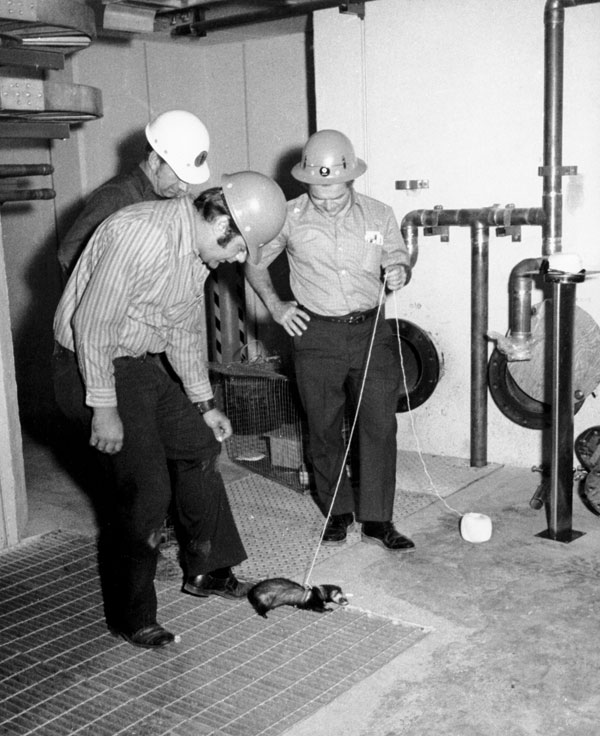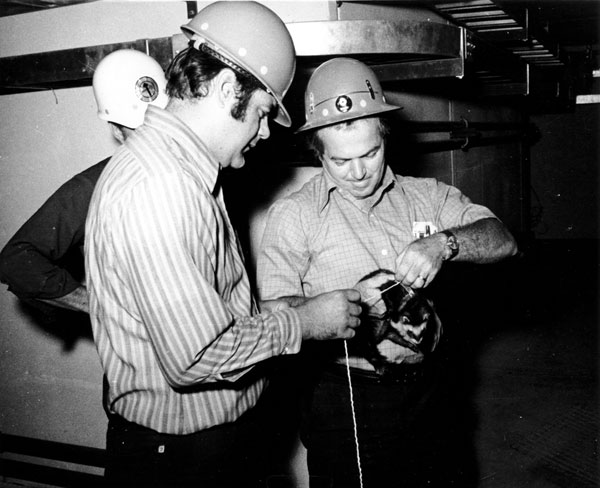Tiny Ferret Aids Construction of NAL Meson Lab
From the dictionary: A ferret is a domesticated, albinistic, red-eyed form of the polecat; employed in Europe for hunting of rabbits in burrows. Usually 21-23 inches long, five inches tall.
Felicia Ferret is playing an important and little-known role in construction of the Meson Laboratory at NAL. She is not on the NAL payroll nor on Social Security, but her activities are saving scores of manhours and getting a difficult job done quickly.
In the construction going on at the Meson Lab, there developed a need several weeks ago to swab out stray steel particles from the long lines that must be spotless for the elementary particles that will zoom through them in a few months. During the design process, Wally Pelczarski, designer in the NAL Main Ring Section, was given the job of designing a mechanical ferret that would be the "meson-cleaner".
In a conversation with Robert Sheldon, the innovative Briton who first suggested that discarded beverage cans be used in designing the geodesic dome near the Neutrino Lab Building, Pelczarski accepted Sheldon's suggestion that live, rather than mechanical, ferrets be used.
So, Pelczarski arranged for the Wild Game and Fur Farm in Gaylord, Minn., to send him the smallest ferret it had on hand. Back, via a special shipment, came Felicia, about 15 inches long, or about 15 per cent smaller than her male counterpart. Felicia cost $35, but has saved NAL hundreds and perhaps even thousands of dollars.
The tiny ferret was chosen because it is known as an observant, curious animal whose hunting instincts make it seek out holes and other items. It also has been used extensively for rat extermination. The first ferret was brought from Africa to Europe several hundred years ago. And the first ferret is reported to have reached the United States in 1875.
Felicia can go through rectangular tubes one and three-eighths of an inch by four and seven-eighths of an inch; holes that are only slightly larger than the size of her head. So far, Felicia has made three 300-foot runs through Meson vacuum pipes that are only 12 inches in diameter. She is scheduled to make nine more "house-cleaning" runs through the Meson vacuum lines in the next few months.
A specially-made collar placed around Felicia's neck carries a string or lightweight rope. The ferret then pulls the string through the pipe. To the end of this string, workmen fasten an appropriate swab which is then pulled through the pipe by the workmen. After that, the vacuum pipe is clean and free of unwanted scrap particles.
Felicia's diet is similar to that of a mink. Some of her food has been obtained from a mink farm in nearby suburban Winfield. Mainly, her diet consists of chicken, chicken livers, raw meat, fish heads, etc. She is also very fond of ordinary hamburger.
Says Don Richied, Meson Lab technician: "Felicia has saved me a lot of time and effort. We'll use her over and over again and perhaps other sections in the Laboratory can put her to work for them as time goes by."
So, it's back to nature for science at NAL. The animal head count now includes buffalo, cattle, sheep, ducks -- and a ferret. Can you ferret that?





